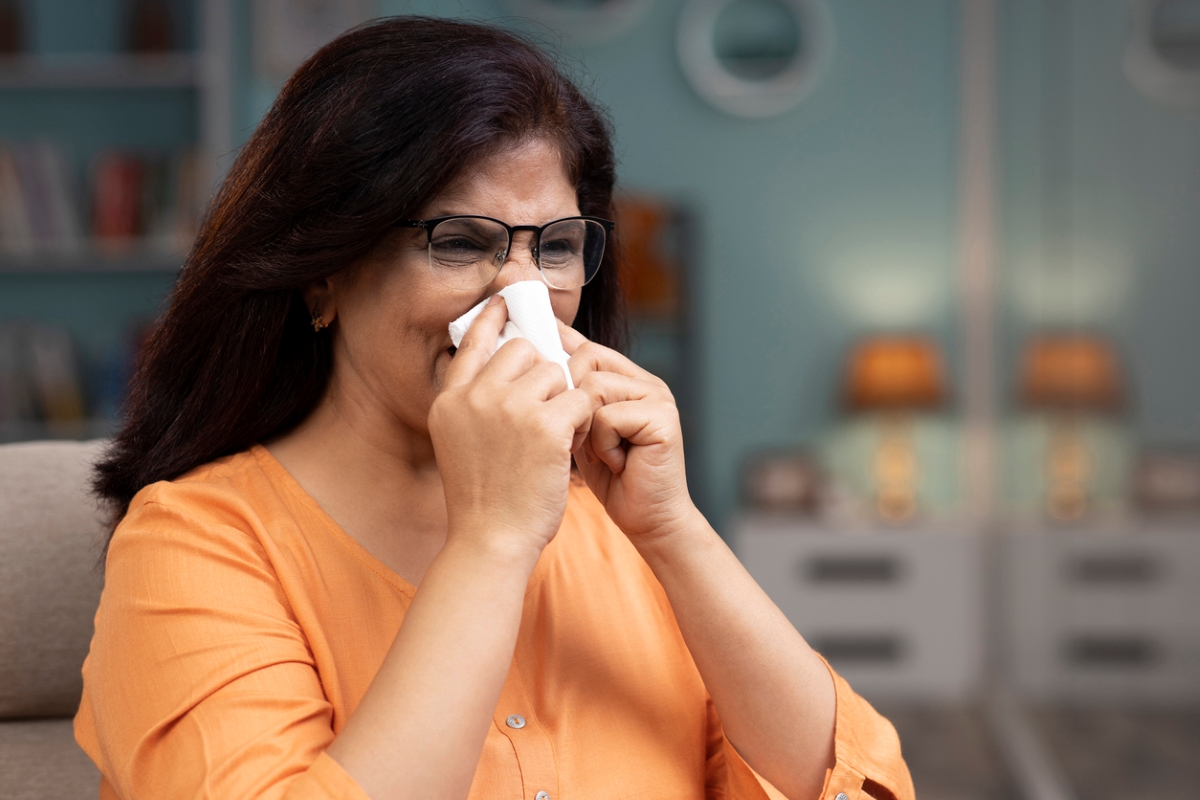Think it's just a cold? It might be an allergy. In this podcast, Dr Gayatri S Pandit explains how to tell the difference between common colds and allergies — and why Bengaluru residents should stop ignoring persistent symptoms.
Published Aug 03, 2025 | 7:00 AM ⚊ Updated Aug 03, 2025 | 7:00 AM

Allergy or cold. (iStock)
Synopsis: In a recent episode of Health for You podcast, Dr Gayatri S Pandit — Consultant ENT and Allergy Specialist at Samarth ENT & Allergy Centre and President of the Allergy Asthma Network of India — explained that what many people casually call a cold or flu might in fact be something far more persistent and misunderstood: an allergy.
It starts with a sneeze. Then comes the runny nose, the stuffy head, and a scratchy throat. Most of them brush it off as “just a cold,” stock up on over-the-counter medication, and wait it out. But what if that “cold” never really goes away?
In a recent episode of South First’s Health for You podcast, Dr Gayatri S Pandit — Consultant ENT and Allergy Specialist at Samarth ENT & Allergy Centre and President of the Allergy Asthma Network of India — explained that what many people casually call a cold or flu might in fact be something far more persistent and misunderstood: an allergy.
“Many times, people who are suffering from allergies think they have the flu and they try to ignore it,” said Dr Pandit. “Flu is a viral infection. You catch it from someone who is already sick. It stays for about a week, and whether you treat it or not, it will go away on its own.”
The bigger issue, she stressed, is when symptoms like nasal congestion, sneezing, and breathing difficulties continue for weeks — or return with seasonal changes year after year. “If you’re sick throughout the monsoon or winter every single year, or you have a leaky or stuffy nose that just doesn’t stop, it’s time to consider that it might not be a cold at all,” she added.
Dr Pandit clarified that allergies and colds can look deceptively similar on the surface — especially in their early stages — but are fundamentally different in cause and treatment.
A cold is caused by a virus. It often comes with fever, body pain, throat infections, and overall fatigue. It’s contagious and self-limiting.
On the other hand, an allergy is the body’s overreaction to a substance that is usually harmless to most people — like dust, pollen, mold, pet dander, or certain foods. It’s not contagious. And unless diagnosed and managed, it doesn’t go away.
“With allergies, the typical signs like body pain, fever or a congested throat are usually absent,” she said. “Instead, you may see itching — in the nose, eyes or even on the skin — and in some cases, symptoms like wheezing or breathlessness. Many people also have two allergic conditions at once — for example, nasal allergies and asthma, or skin allergies and food reactions.”
Dr Pandit was also quick to address a common linguistic error that muddles both public understanding and clinical diagnosis.
“Allergy is a misnomer many a times,” she said. “People say, ‘I’m allergic to upma’ — but what they mean is, ‘I don’t like upma’. That’s not a medical allergy. For us as specialists, an allergy is a very specific immune reaction — something we call an IgE-mediated response.”
These reactions can be triggered by proteins that are harmless to most people. “For example, peanuts are safe for most of us. But for someone with a peanut allergy, even a small amount — sometimes even the smell of roasted peanuts — can cause a severe or even fatal reaction.”
This hypersensitive state, she said, is the crux of what defines an allergy. “It’s not that the substance is toxic — it’s that the person’s immune system is hypersensitive to it.”
Living in Bengaluru — a city with rising dust levels, fluctuating weather, pollen-rich air, and a growing dependence on closed spaces — may actually increase the chances of developing allergies or worsening them over time.
“Bengaluru’s dust, climate, and the way people live — with closed windows, carpets, air-conditioners, and pets indoors — all contribute. Allergens get trapped inside, making symptoms worse.”
This has earned the city a reputation as one of India’s allergy capitals — especially for respiratory and skin allergies. Yet, many patients go untreated for years. “They think it’s ‘normal’ to be sneezing all winter or coughing through the monsoon. But it’s not. These are clear signs of a chronic allergic condition, and the longer you ignore it, the more complicated it can get.”
Dr Pandit strongly advises against self-diagnosis and urges people to get tested.
“You can’t fix what you don’t understand. Allergy testing helps you identify what specific trigger is causing your symptoms — whether it’s a food, a dust mite, a pollen, or something else in your environment.”
Once identified, most allergies can be managed with a combination of lifestyle changes, medications, and — in some cases — immunotherapy.
“The good news is, allergies are manageable. You don’t have to live with constant sneezing, breathlessness or skin irritation. But you do need a proper diagnosis.”
(Edited by Sumavarsha)
